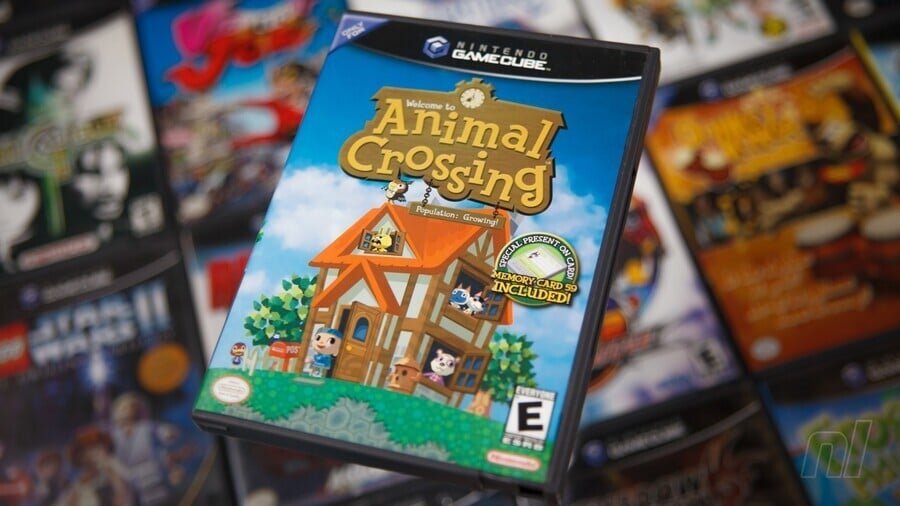
Like most games made by Nintendo, the story of Animal Crossing – Nintendo’s charming social life-sim series – begins in Japan, with a man named Katsuya Eguchi. After he nabbed a job at Nintendo in 1986 he was forced to move away from his hometown of Chiba and relocate to Kyoto, the city where Nintendo was (and still is) based. Eguchi worked on several projects hither and thither, notably as a level designer for Super Mario Bros. 3, but the move to Kyoto stuck with him even after he had settled in, and it was a primary influence upon the creation of Animal Crossing.
Eguchi elaborated on the main themes of the original game in an interview with Edge Magazine:
Animal Crossing features three themes: family, friendship, and community, but the reason I wanted to investigate them was a result of being so lonely when I arrived in Kyoto […] when I moved there I left my family and friends behind. In doing so, I realised that being close to them – being able to spend time with them, talk to them, play with them – was such a great, important thing. I wondered for a long time if there would be a way to recreate that feeling, and that was the impetus behind the original Animal Crossing.
Joining forces with the ever-excellent Takashi Tezuka, Eguchi began the series with Dōbutsu no Mori, a Japan-exclusive game for the N64 which roughly translates to ‘Animal Forest’ in English. The game was originally planned to be released for the 64DD, an add-on which sat under the N64 and took advantage of rewritable, whizzy, spinny discs that could hold a lot more data than a cartridge. Unfortunately, the expansion was a commercial disaster and after countless delays and other problems, Nintendo decided to slap it in a cartridge instead.
There was an issue with this however, as the game relies heavily on a real-time clock, which the 64DD offered but the N64 lacked. Therefore, Nintendo did the only sensible thing and stuck a clock inside the game cartridge. Whilst it worked for the most part, relying on such a solution meant that should the battery run out there’d be no way for the game to track the time when you weren’t playing, which is a significant issue given that that was one of the biggest features.
From N64 to GameCube
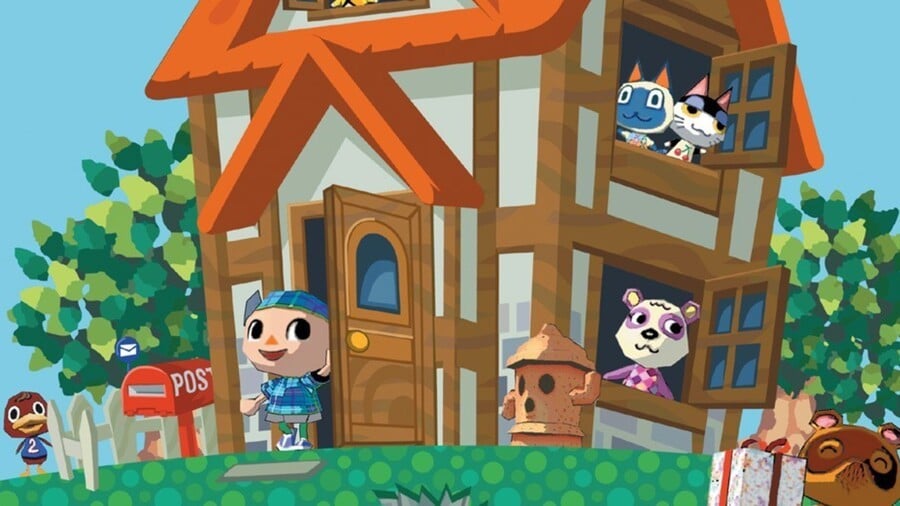
This initial release on N64 launched in Japan on the 14th April 2001, but it wasn’t long until a new and improved version called Dōbutsu no Mori+ released for GameCube in December of the same year. The fact that the GameCube actually had a clock in it made fabricating discs easier (and cheaper) than producing more cartridges for the ageing, older Nintendo 64, even if the upgraded game still looked very much like an N64 title.
The GameCube version also came with a selection of new stuff as well, much of which has remained throughout the entire series, including Tortimer, Kapp’n, the Able Sisters, and the Museum. Suffice it to say if you bought the N64 original and then saw this less than 9 months later, you’d probably feel a bit miffed. Still, it’s hard to stay mad while playing Animal Crossing.
The success of the game caught the interest of some other Nintendo employees outside Japan, and despite the mountains of dialogue and text that had to be localised, Nintendo of America set about making what most of you reading will recognise as Animal Crossing for the GameCube, with its classic tagline ‘Population: Growing!’ that still gets ignored to this day. Not only did they translate everything, but they also decided to add in other things such as new holidays. The original game was very Japan-centric when it came to annual festivals, but adding in things like Toy Day (Christmas) and Halloween (Halloween) helped to make the game more recognisable and relatable to a western audience.
Animal Crossing launched in North America less than a year following its Japanese counterpart on the 16th September 2002, although Europeans had to wait a further two years to get their first taste of animal-forest life. The game was well received, but more interestingly the Japanese portion of Nintendo were so impressed with Nintendo of America’s additions that they decided to take all the new content from the western release (plus a bit extra) and release yet another version of the game called Dōbutsu no Mori e+ a year before the European release. The game was even released on the iQue Player in China in 2006, so perhaps Europeans should count themselves they didn’t have to wait until after that launch to play.
The game was a hit, and dominance over the debt simulator genre had been established, so it was time for a proper sequel.
Ooo, baby baby it’s a Wild World
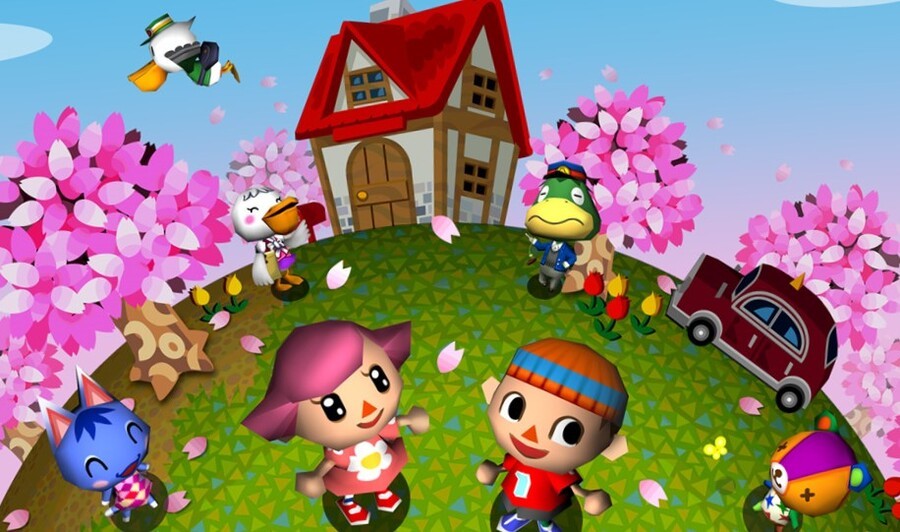
Even though the game had started small and local, Animal Crossing’s success was global, so when it came time to make a sequel Eguchi made sure to change things around for as broad a demographic as possible. Everything from fish, to bugs, to fossils, to holidays were re-designed with an international, multicultural market in mind. The platform choice was a bold move as well, as even though the GameCube had sold a respectable number of units, this new game would be shrunk down onto the tiny Nintendo DS instead.
Despite its size, the DS packed quite a punch features-wise including in-built features that the GameCube didn’t possess, like a microphone that you could use to scream at other villagers to find out where they were. Parents loved that. Animal Crossing: Wild World also had the major advantage of not having to rely on being plugged into the wall at all times, meaning you could take your village with you wherever you went. The DS also technically had Wi-Fi capabilities, so you could visit other people’s villages locally or non-locally using the patented Friend Code system and even send them charming or rude messages.

The game was a smash hit, and thanks to the overwhelming success of the DS in all its ‘third pillar’ glory, superseded the original release financially, and critically. Taking the winning formula and improving on almost every aspect in a handy portable package was a no-brainer to consumers, and the series’ relaxing gameplay appealed to the same broad demographic of players attracted to the Nintendo DS by games like Brain Training and Nintendogs; players who might never have sat down to play something on GameCube but were willing to try something new on DS.
There were a few issues however. With the introduction of the new whizz-bang internet Nintendo had the ability to distribute letters containing gifts to people fancy enough to have a connection, and they did so. One gift called ‘Red Tulips’ came with a blank letter and after placing the mysterious object in your home, not only would it be invisible, but the game still thought there was something there, so you couldn’t move through it. Whatever was there couldn’t be touched or moved, so you weren’t able to pick it back up either, meaning you now had an invisible blockade in your home. Nintendo’s response was swift, and its solution to the problem simple: don’t open the letter and just throw the item away. Genius.
Wild World was a marvel back in the day, a handheld jewel that married the charm of the series with the convenience of portability. The Wii U Virtual Console version neutered that convenience somewhat, but this entry sucked hundreds of wonderful hours from us back on DS.
Nuts to parochial backwaters: Let’s go to the city!
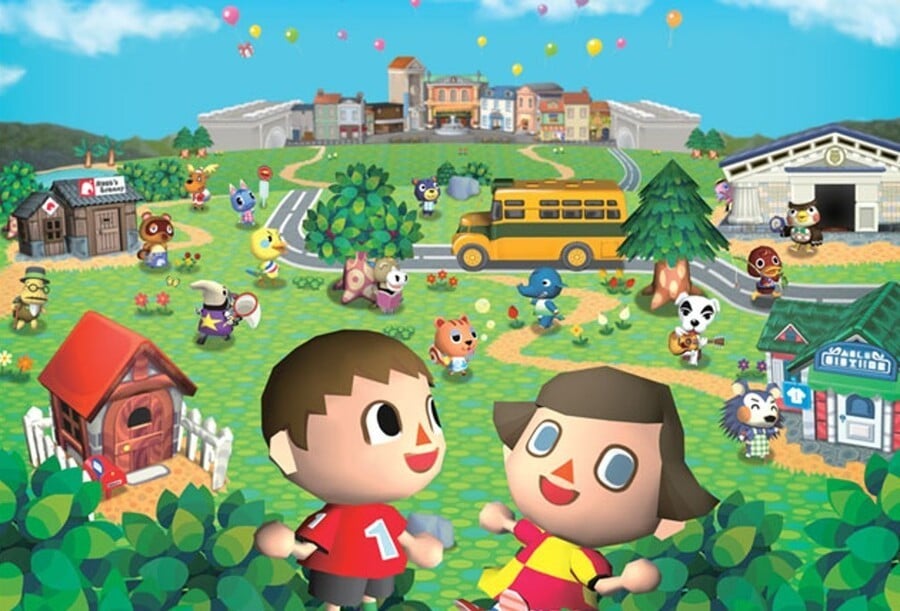
Portable play is all well and good, but what if you had a real hankering for that classic big screen experience on your 12-inch CRT with only one working speaker? With the 2006 launch of the Wii came a two year wait before the series returned to home consoles with Animal Crossing: Let’s Go To The City!. Or at least that’s what it was called in Europe. In North America it went by Animal Crossing: City Folk because Nintendo of America refuse to publish any game with more than five words in the title. To be honest, we endorse such practices and wish they were still employed; it would avoid multi-syllable embarrassments like Cadence of Hyrule: Crypt of the Necrodancer Featuring The Legend of Zelda or that Dragon Quest XI: The Longest Title In The History Of The World…Ever! – Definitive Edition.
If the name didn’t give it away at all, Let’s Go To The City allows you to venture outside the peaceful tranquillity of your town and, yes, go to a city. That was about the only major difference between this and Wild World, though, and the game was criticised for being too similar to its predecessor. Part of that may be because it’s based on exactly the same game engine as the DS version. You could have more villagers, your own home rather than sharing one with anyone else who had a character in the game, but much of City Folk was subject to only very minor changes.
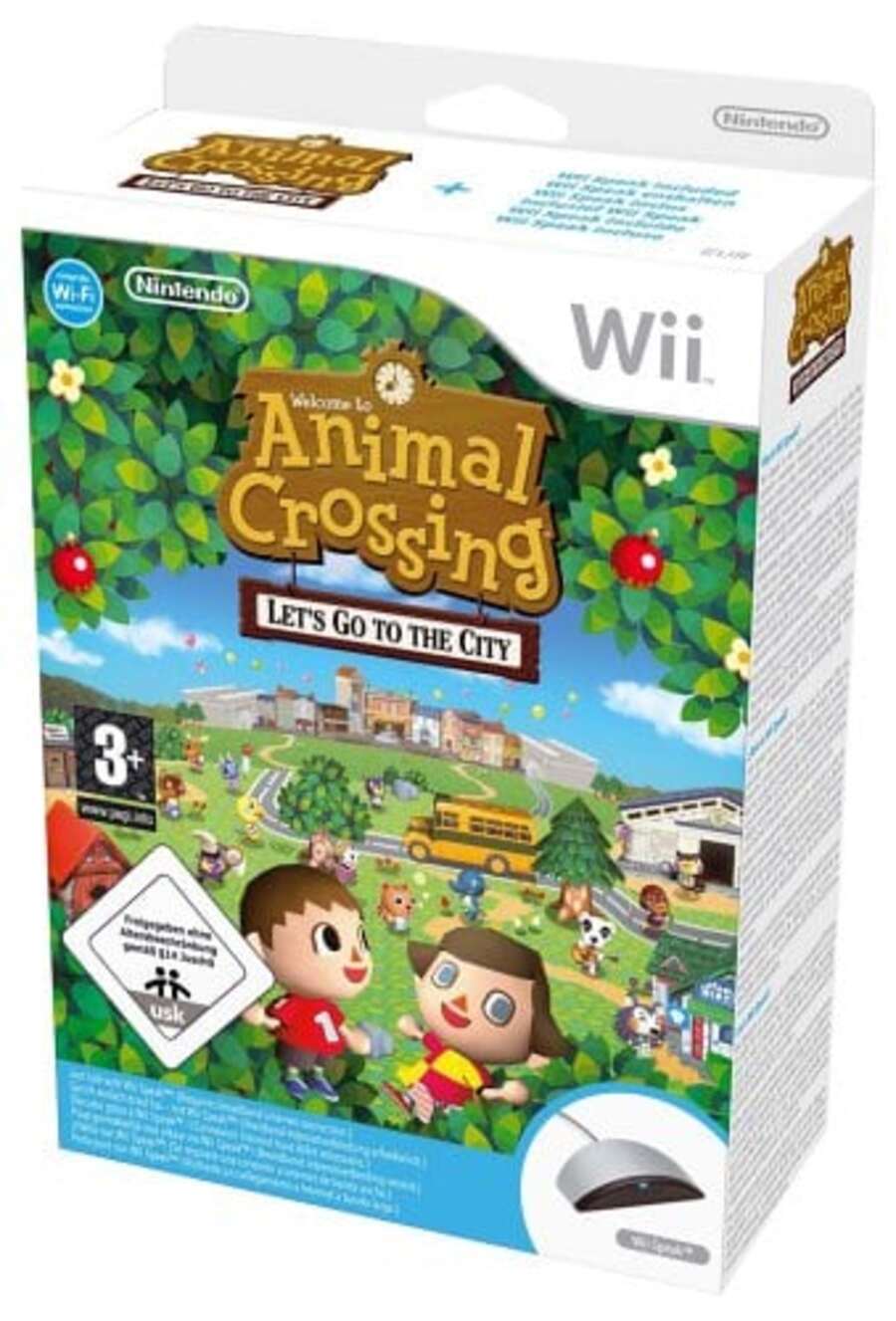
One area touted as an improvement over Wild World was the Wii Speak peripheral released alongside this new Wii game. This was essentially a big microphone that you could place near your TV and talk to people as though they were in the room with you. That was Nintendo’s plan at least. In reality it was a largely disappointing, low-quality microphone that forced you to shout at your TV rather than just whisper delicately into a headset (not that people don’t shout into headsets). The Wii Speak only ever supported 13 games, and it’s not hard to see why.
But what about the headlining trip to the city? That must be exciting, right? Well, you could buy clothes, change your hairstyle or fashion yourself a Mii mask, talk to special characters… the city area basically freed up your town to be more focused on your villagers rather than cluttering it all up with shops. As an idea it works well enough, but it also feels strangely disconnected to your actual town, and left it feeling somewhat empty at times. It’s certainly not the bustling MMO metropolis you might have hoped for.
Consequently, Animal Crossing: Let’s Go To The City ends up as one of the lesser games in the series as it didn’t really push any boundaries beyond what had already been done before. That’s not to say Nintendo didn’t put work into the Wii entry (according to the game’s Iwata Asks interview it features the equivalent of 4000 pages-worth of text), but in a series of slow and steady iteration, City Folk was the slowest and steadiest of Animal Crossings. If it was your only Animal Crossing game at the time you would probably have been more than happy with what you had, though. Still, it wouldn’t be long before you could start over again.
Turning over a New Leaf
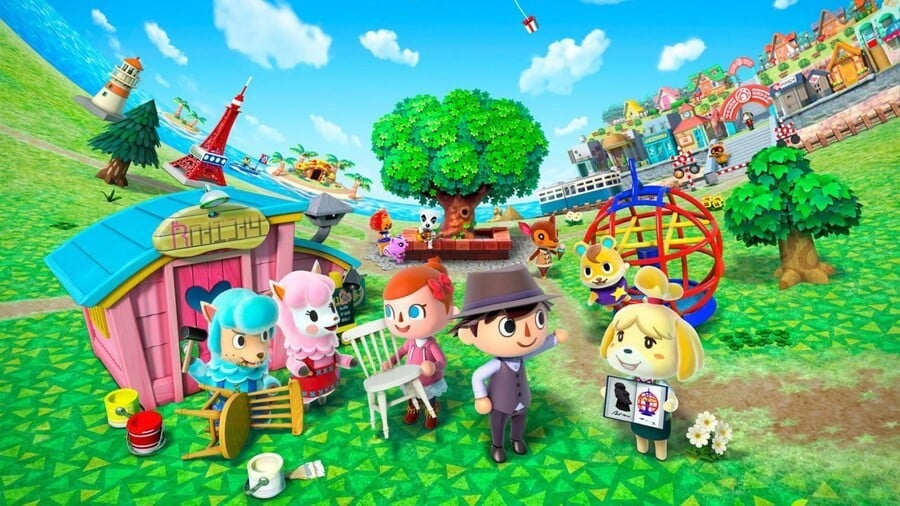
Whether or not Let’s Go to the City’s lukewarm reception was a reason or not, the next game in the series returned to a handheld, specifically the Nintendo 3DS. Animal Crossing: New Leaf took even more inspiration from around the world and squeezed it all onto a diminutive cartridge once again. The autostereoscopic 3D display of the console meant the designers had to take extra care to make sure the new perspectives didn’t reveal any behind-the-scenes graphical nastiness that we were never meant to see. The game launched in 2012 in Japan and the following year everywhere else due to another monumental localisation job.
This time around you’re not just some schmuck selling seashells and fallen fruit in an already flooded market, but instead upon arrival at your new town you’re greeted as the new mayor of this rural backwater, with the power to mould and shape the town (and its inhabitants) according to your whims. Being the mayor means you have the ability to change more of your town than ever before, and even dictate people’s bedtimes to suit your own unhealthy schedule. Despite this being such an integral part of what made New Leaf New Leaf, this idea was only decided on a year after the game had started development, as revealed in an Iwata Asks interview on the subject. In fact, it was an impending presentation to a couple of Nintendo honchos that birthed the idea of giving the player more control this time around:
Kyogoku: … we were preparing to make a presentation to Shigeru Miyamoto-san and Takashi Tezuka-san, and we started to wonder how we could possibly sum up the idea behind the new Animal Crossing in a single key word or concept.
Iwata: And this ended up being: "The player is the mayor."
Kyogoku: Yes. The player becomes the mayor, so he or she can put up bridges and install various items and objects. This makes the whole feature similar to public works projects in the real world.
And with Tortimer booted from office the next chapter of Animal Crossing had its Unique Selling Point.
The game was very well received, and in 2016 - a full three years after its initial release - an updated version called Animal Crossing: New Leaf - Welcome amiibo landed on store shelves. As the new title suggested, this was a revised version of the game that boasted new amiibo functionality and extra modes including an expanded camp site, but those with the base game were able to simply update their original copy to include all the new features for free thanks to the mysterious magic of the internet. Shortly before this updated version released, though, we saw the very first spin-off in the series.

Comments 24
I am an AC virgin and am looking forward to popping my (furry?) Cherry with the Switch release 😀
Animal Crossing is one of the most unique franchises ever. It might be the only series that I get excited for when they release a new screenshot of a sofa.
Seriously though with all of the issues going on in our world right now, I cannot think of a better time to get lost in a new AC game with all of my gaming buddies.
I remember when this game came out on the gamecube, it was kind of a cult thing that I never got into. I remember how the game was sold with it's own memory card because it took up so much space for the time. Wild World for the DS is when the series really blew up it seems, that is the first version of the game I really got into and having it on a portable made it the kind of experience where you could easily just check in all the time. I have never been the biggest fan of the series but I think it's got a lot of charm and I am looking forward to checking out this latest Switch version. I think it's the kind of game that I sort of grow to appreciate as I get older, now a days I really enjoy these slower paced games.
@Dayton311 I actually withdrew to a lifestyle in a cabin in the woods, surrounded by animals.
No joke. It's the only way I can find SOME peace.
Now the government is trying to bully me out, make me destroy my tiny little home, or pay €1150 -that I don't have, let alone want to give to them- EXTRA tax extortion every year on top of that which I already pay.
Gone peace.
Why? "To demotivate living in forest areas, and protect forests and living in the city". Also, "if you have a house in a forest you must be rich". The only reason it's still a forest here, the animals and trees here have nothing to fear, and have not been killed and cut down and built upon in concrete and steel, is because I live here... And I may FEEL rich on a good day, but by their standards, I live way below the limits of poverty.
I always love reading about Animal Crossing.
@Dayton311 I get how you feel. I came into the series around New leaf and Im still playing it still till this day, and I love the game series, so when I found out they had New Horizons I was like I can't wait. But ya playing with your friends is awesome specially since New Horizons is four players, can't wait. I havn't played anything before New Leaf but I have been trying to find the games especially the one on gamecube because I have my gamecube ready to pop the game in and start.
This was fun to read, always like reading about the history of any game series.
My first venture into the series was New Leaf and I was instantly hooked. New Horizons looks like a significant step up in every way. Gonna be a fun time. 😀
I'm ready to spend several hundred more hours in my favorite feng shui simulator.
This is gonna the best game of the year. Nobody develops such unquie franchises like Nintendo. I don't understand how they can develop so many games. Sony and Microsoft make like one game a year.
Can't wait for New Horizons! Got the limited edition console pre ordered. Wild World was my first animal crossing game and I'm so glad I got it all those years (14!) ago. Introduced me to such a lovely series 😊
Ahh, Animal Crossing, the original Virtual Console.
My first timer
@mesome713 A little presumptuous seeing as we're only in March, but I'm sure they definitely appreciate the spirit! And yeah, I agree on the MS and Sony front. Number of dev teams aside, Nintendo makes a quality software product that MS and Sony's first-party teams can't even touch. Sure, ARMS or amiibo Festival are on par with Knack or LittleBigPlanet as far as concepts go, but Nintendo's gameplay is rock-solid compared to theirs.
@AlienX & @JayJ, The playable NES games on the GC version were a great bonus. Good times!
I got into animal crossing by accident. I grabbed the happy home designer new 3ds bundle that released in North America because I wanted a new 3ds with a white interior and that was the first one available. Figured what the heck might as well try the game it came with, downloaded new leaf a week later
Been playing Nintendo since the beginning and I have never paid any attention to the Animal Crossing series. It's just not for me. But...my wife just got herself a Switch Lite and she's intrigued. So I read this article to find out what the big deal is and...I guess I get it.
She likes easy going, slice-of-life creative games like the Sims and what not, so I'm thinking she might find this charming.
I only vaguely knew the series existed prior to New Leaf. Though I suspect I would have liked it had I tried it. My best friend talked me into getting New Leaf after she got it and I have loved the series since. Though people have told me there is little reason to go back and try older titles.
Animal Crossing New Leaf 3DS was my first time i got hyped with the game after 1 - 2 weeks i played. 😀
I remember this game coming out on the GameCube. I remember looking at it as yet another reason to be disappointed in Nintendo. The GameCube is my least favorite Nintendo system. I thought the game sounded silly. My thinking back then was, if it wasn’t the Sims, why bother? This, along with Pikmin, havr surprised me with their fandom and longevity. I still haven’t played one single AC game, but it’s fun to read about the games and the fans reaction. Like when people lost it over some character being featured at the end of one of Nintendo’s announcement videos. I think it was a female character and she was sitting in an office setting.
I've only played New Leaf - only started playing it from January last year - and am still going. I wasn't planning to get New Horizon day one because of the season in the south is heading into winter and camping would seem miserable and was satisfied to experience New Leaf through autumn and summer again. Now I changed my mind.
Since I never played Wild World, City Folk was my first Animal Crossing game and I have some fond memories of it. Playing Animal Crossing on a home console feels more immersive, even if you can't take it with you-
Wow, suddenly Animal Crossing on Switch felt more perfect
"The DS packed quite a punch features-wise including in-built features that the GameCube didn’t possess, like a microphone that you could use to scream at other villagers to find out where they were. Parents loved that." hahaha
What I nice article. I highly enjoyed reading it.
@kalosn Yeah, although I never got to play either of the console versions as New Leaf was my first Animal Crossing experience, I always imagined it would feel quite different to be playing the game on a big tv rather than a handheld, especially since I've always been more of a console than a handheld guy. In that way the Switch almost feels like it was custom made for Animal Crossing. You get both experiences in one system. Although I'll likely be doing most of my New Horizons playing on the big tv at home, I imagine I'll also take frequent advantage of the handheld mode simply because it's kind of game that encourages daily play and you don't always have the time or the ability to dedicate to playing at home.
I remember having to choose between this and NFS:UG. I got this and was immediately hooked.
There was no pressure to beat anybody or anything, there was a real sense of freedom and there was so much to do. It was relaxing in a way no other game had been before.
I can’t wait to jump back into AC after not having played since the first one.
Leave A Comment
Hold on there, you need to login to post a comment...